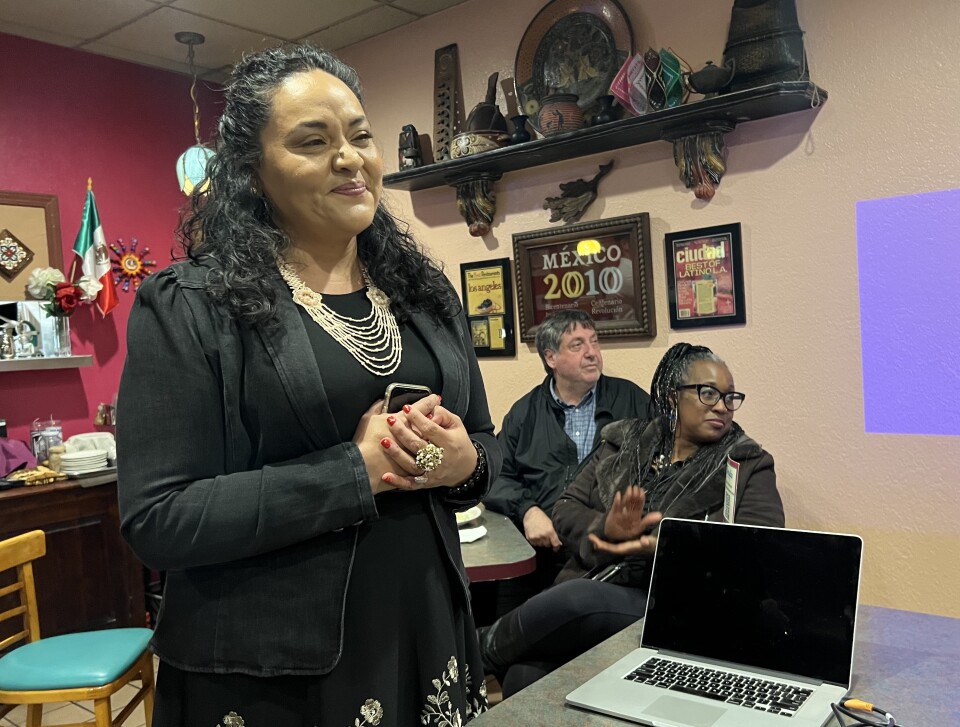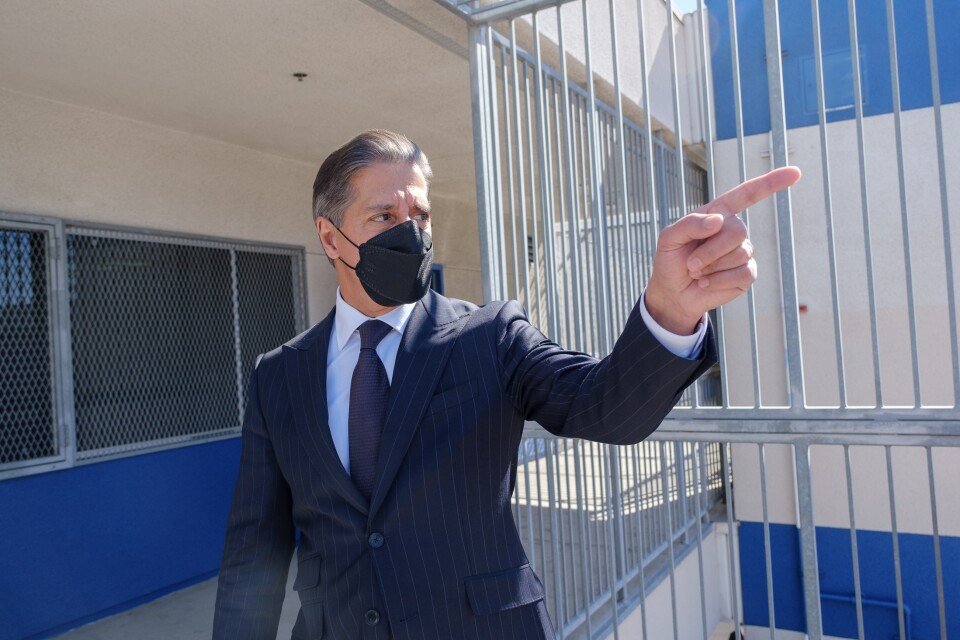Truth matters. Community matters. Your support makes both possible. LAist is one of the few places where news remains independent and free from political and corporate influence. Stand up for truth and for LAist. Make your year-end tax-deductible gift now.
Teachers Union Allies Are Back In Control Of The LAUSD Board. Here’s What That Might Mean

On election night 2017, Los Angeles’ teachers union leaders watched as their allies on the school board — facing a tidal wave of outside spending from charter school interests — lost their seats, leaving union sympathizers in the minority on the powerful school board.
Five years later, United Teachers Los Angeles is back in the driver’s seat.
UTLA members and sympathetic parent activists rallied around Rocío Rivas, who declared victory last week in the election for the open District 2 seat, which represents parts of east and central L.A.
With nearly all the votes counted in the race for the east San Fernando Valley’s District 6 seat, incumbent Kelly Gonez also appears to have fended off a stiff challenge from teacher Marvin Rodríguez to secure re-election. Once considered an opponent, the union now officially counts Gonez as a supporter, endorsing her bid for re-election over the bid of one of its own members. (Many rank-and-file members remain lukewarm on Gonez.)
Rivas’ and Gonez’s likely victories strengthen UTLA’s political position at a crucial moment. LAUSD is negotiating with union officials for a new contract, and union officials have attempted to convince district officials of broad community support for UTLA’s demands, which include greater salary increases and across-the-board class size reductions.
“Regardless if I’m being endorsed by the union or not, I’m here to really fight for our teachers,” Rivas said in an interview on election night, “and make sure they have the best working conditions, that they’re being listened to and that they matter.”
“I’ll be fighting,” she added, “and having serious discussions with the superintendent and district leadership [about] how to improve our schools, and how to improve our schools is: taking care of our employees.”
Like in 2017, UTLA’s rivals outspent them in this election. In the District 2 race, two deep-pocketed UTLA critics — Bill Bloomfield and Reed Hastings — as well as the school district’s second-biggest labor union, SEIU Local 99, spent a combined $5.6 million trying to swing the race to Rivas’ opponent, longtime community organizer María Brenes.
By comparison, Rivas benefitted from around $2.9 million in outside spending — all of it from UTLA.
Here’s what we think victories for Kelly Gonez & Rocío Rivas mean for LAUSD:
A Stronger Majority For Teachers Union Allies
Three years ago, Rivas was among the candidates who finished behind Jackie Goldberg — a UTLA favorite — in the primary race for another LAUSD board seat.
After that 2019 campaign, Rivas became a Goldberg protegée, going to work in the new board member’s District 5 office. Rivas assumed she was setting herself up to run after Goldberg, now 78, stepped aside. When the 2021 redistricting process redrew LAUSD’s board boundaries, Rivas found herself living in District 2 — and getting encouragement to run for the seat.
“It’s an opportunity I couldn’t pass,” Rivas said in a June interview.

Now that she’s won her own board seat, Goldberg and Rivas will serve on the board together — and could form a formidable pair of UTLA allies.
Her win in District 2 also marks a further shift of power in UTLA’s favor. Union leaders have said the termed-out incumbent, Mónica García, is too close to union skeptics and the charter school movement. The union threw most of its resources into District 2 in hopes of swinging the race to Rivas — and to prevent Brenes, whom García supported, from winning it.
Now, a solid majority of LAUSD’s seven board members will have received UTLA’s endorsement: Rivas, Goldberg, Scott Schmerelson, George McKenna — and this year’s District 6 winner, Gonez.
Gonez also ran with significant support from UTLA’s rivals. She had charter school advocates’ endorsement in her 2017 campaign, and Bloomfield and Hastings spent nearly $300,000 backing her run this year. But UTLA officials note Gonez has come through for the union with supportive votes on key issues, from charter schools to school police.
A Rising Risk To Charter Schools
Charter schools are publicly-funded, privately-run schools. LAUSD board members regulate them, but they don’t control their day-to-day operations — and charters compete with district-run campuses for resources.
Between 2000 and 2015, charters in L.A. looked like an unstoppable force. Student enrollment in charters boomed along with the movement’s political fortunes: in 2017, charter-backed LAUSD candidates won a board majority.

Since then, charter enrollment has plateaued — and charter advocates’ hold on district politics has loosened significantly. No clear champion for charter schools emerged in either of LAUSD’s 2022 races; none of the candidates said they felt charters should be allowed to grow.
But one candidate stood out from the pack for her opposition to charters: Rivas.
Rivas said she would make closing charter schools that aren’t meeting their academic, financial, or enrollment goals part of her strategy to combat enrollment decline on LAUSD-run campuses. She also promised to make full use of the district’s powers under Assembly Bill 1505, a new state law that could block charters’ expansion in certain neighborhoods.
“I’m not here to close [charter] schools,” Rivas said. “I just want to make sure that low-performing charter schools are addressing the needs of our students. If they’re not performing, we have to address that. The district has to be a bit stricter and have good oversight of our schools.”
There are many open questions about how the new charter law will work. Key provisions of AB 1505 took effect during the pandemic — and the law also theoretically protects charters with high test scores from closure. Even low-performing schools closed under AB 1505 could still appeal their closure.
But the law gives Rivas and other charter critics leverage they’ve never had before — and Rivas won’t be alone: Goldberg made similar pledges to curb charter expansion in her 2019 campaign.
More Job Security For The Superintendent
Gonez’s impending victory in particular is welcome news for Superintendent Alberto Carvalho.
Gonez was instrumental in the board’s decision to hire Carvalho a little more than a year ago. Gonez has praised Carvalho, noting the new superintendent quickly fulfilled one of Gonez’s top priorities: write a strategic plan that school board members could get behind.

“So far, he has been successful in his work,” Gonez said in a recent interview.
While Gonez’s opponent didn’t run as a Carvalho skeptic, Marvin Rodríguez had also critiqued the superintendent’s leadership style: “This isn’t the superintendent show.”
In a September interview, Rivas said she was withholding judgment of Carvalho as the UTLA contract negotiations unfolded.
“I'm expecting him to really listen to the community,” Rivas said. “I'm expecting him to really give what the teachers deserve. They need higher salaries, they're struggling themselves. I have high expectations for him, and right now I'm waiting with those expectations to see if they're being met.”
A (Possible) Setback For The ‘Equity Alliance’
The public dialogue over charter schools once again crowded out a far more consequential subplot in this year’s LAUSD board election: the influence of the “Equity Alliance.”
In recent years, this alliance — which includes InnerCity Struggle, Catalyst California and Community Coalition of South L.A. — has succeeded in LAUSD to redistribute millions of dollars to higher-need schools, raise graduation standards, and revisit harsh discipline policies.
Brenes’ loss in District 2 is a measurable setback for this alliance. For years, this coalition could count on García to introduce legislation they favored for board votes. Brenes — the executive director of InnerCity Struggle — might have been able to pick up where García left off.
There is still an Equity Alliance alumna on the school board — Tanya Ortiz Franklin, a former staffer at the Partnership for L.A. Schools — but the loss of García will leave the coalition on weaker footing.

In some ways, the Equity Alliance and UTLA’s agendas overlap. Both the union and Alliance-tied organizations supported ending LAUSD’s random student search policy, and slashing the district’s school police budget (more on that in a second).
But the two camps also have divergent views of what it means to “progressively” fund schools.
The idea underlying the Student Equity Needs Index — the Alliance’s signature idea — is that LAUSD ought to target resources to schools serving the very highest-need students. Despite massive infusions of new state funding meant to help English learners, foster youth and low-income children, Alliance members have held that LAUSD diverted too much of this funding to schools serving more-affluent constituencies. This funding index is meant to correct this inequity.
By contrast, UTLA’s agenda emphasizes sweeping, expensive district-wide initiatives: across-the-board class size reductions, broad-based faculty salary increases and funding additional staff positions at each school — all expensive programs, and not necessarily targeted to schools that have been historically overlooked. UTLA argues raising the tide for all schools is necessary after years of underfunding in California schools.
Despite their differences, the union’s and Alliance’s conceptions of school funding are not necessarily mutually exclusive. Rivas said she sees valid points on both sides of the funding argument.
“We also have to make sure those targeted supports are going to what they’re supposed to go to,” Rivas said, referencing an independent evaluation that found mixed results so far from LAUSD’s Student Equity Needs Index.
Both Gonez and Rivas have said they’re open to changing the index.







